RIPE Atlas lets you make customised measurements from thousands of probes around the world. These measurements cost credits, which users usually earn by hosting or sponsoring RIPE Atlas probes - or you may have just been given a million RIPE Atlas credits as a member of one of the Regional Internet Registries. Find out how you can best spend your credits to check your services' connectivity and troubleshoot potential issues.
Just became a RIPE Atlas millionaire? Congratulations! There's a lot you can do with RIPE Atlas credits, from measuring your home connectivity to troubleshooting network issues.
Here are some ideas of what you can do with your million credits to help get you started.

Setting up measurements and viewing results
The six basic measurements available through RIPE Atlas (ping, traceroute, DNS, SSL/TLS, HTTP, NTP) are accessed from the main Measurements page. Simply click on the green "Create a Measurement" button at the top of the page and you'll be guided through your measurement set-up (make sure you're logged in to RIPE Atlas first or create a RIPE NCC Access account if you don't already have one).
As you set up measurements, you'll see a handy calculation on the right of the page called "Costs summary" that shows you how much the measurement will cost each day, what percentage of your daily credit income it requires, and how long you can afford to run it given your total credit balance. You can play with the different measurement parameters to see how this affects the credits required to run the measurement.
For example, using more probes will increase the cost, while scheduling a measurement to run less frequently will decrease the cost. No matter how many credits you have, there's sure to be a measurement that's useful to you.
Measurement results are available both from the Measurements page as well as from My Atlas , where you'll also find information related to your probes, credits and API keys. Just click on a measurement to see the results. You'll get a general overview of the measurement results, as well as other views (see the traceroute example below for more details).
What can 1,000,000 credits do for you?
Here are a few examples of different types of measurements you can do with 1,000,000 RIPE Atlas credits. (Of course, you can also do a lot with fewer credits, too!)
Ping (simple)
Let's say you're a network operator who receives complaints from customers about intermittent problems reaching your network. You can use RIPE Atlas measurements to determine which regions are experiencing problems and when they're experiencing them.
With 1,000,000 credits, you could schedule pings from 50 probes worldwide to run every five minutes for three weeks .
Just go to the Measurements page on the RIPE Atlas website and click on the green "+ Create a Measurement" button at the top of the page (make sure you're logged in first). You can fill in as many of the fields as you like, such as the interval field to determine how often your measurement will run, or you can just enter your target and leave the default values in place for the rest of the fields.
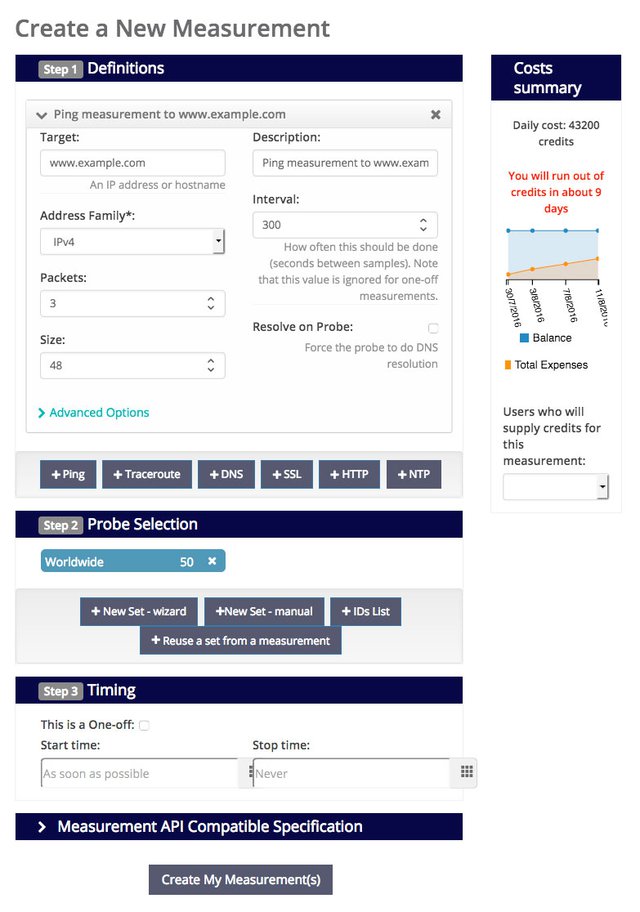
The measurement creation wizard is easy to customise with more advanced options - or you can just use the default values
Once your measurements have started, you'll be able to see them listed under My Atlas . Just click on the measurement to see that measurement's results, including an overview of the percentage of unreachable probes, a map showing RTT values for the different probes trying to reach your network, a more detailed page showing RTTs and packet loss per probe, and more.
Together, these results can help you pinpoint when and where your customers are having trouble reaching your network so that you can better diagnose the problem.
Traceroute (simple)
If you suspect there are reachability problems between your server and a specific network, you can start a traceroute measurement from the probes in a particular AS or country.
Just go to the Measurements page, click on the green "+ Create a Measurement" button at the top of the page (make sure you're logged in first), and select "traceroute" from the available options. Once again, you can fill in as many of the fields as you like, or you can just enter your target and leave the default values in place for the rest of the fields.
With 1,000,000 credits, you could schedule traceroutes from 350 probes every 15 minutes for 24 hours .
Again, you'll get a results page for your measurement that shows an overview of the responding probes, along with tabs for more detailed information for each probe used in the measurement, a map of RTTs, and more.
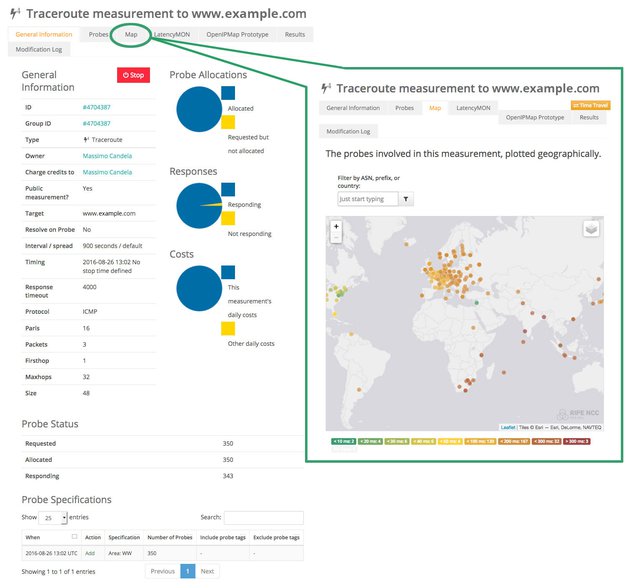
Traceroute results showing the map visualisation of RTTs
DomainMON (more advanced)
DomainMON is powered by the same technology as DNSMON , which monitors various important DNS root and TLD name servers. DomainMON is like a "personal" version of DNSMON that can be used to monitor your own name servers - or any others of your choosing. It visualises the results in a matrix that gives you a quick overview of the quality of service offered by your name servers.
Coupling DomainMON with traceroute measurements gives you an even more comprehensive view of your name servers. While DomainMON will give you information about whether your name servers are responding, packet loss and RTTs, adding traceroute measurements will highlight changes at the network level. Together, these measurements are costly (in RIPE Atlas credits), but extremely useful.
Go to the DomainMON page and click on the green "Monitor a new domain" button. Enter the domain you want to monitor and you'll get a list of the different name servers belonging to that domain. You can choose which of these you want to monitor, how many probes and which regions you want to use, which types of measurements you want to run (UDP SOA, TCP SOA, ICMP traceroute), and how often you want the measurements to run.
With 1,000,000 credits, you could monitor two name servers for example.com and schedule traceroutes from 50 probes every hour for 10 days .

Setting up DomainMON and traceroute measurements for two domain name servers for example.com
Once you have collected enough measurement results, you can see them visualised by clicking on the "visualise" button at the top of the
DomainMON
page.
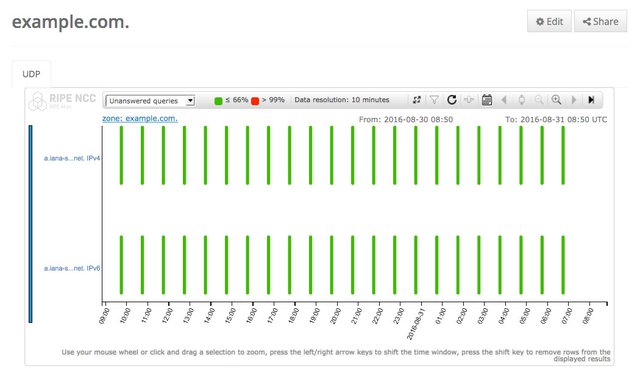
DomainMON results give a quick overview of unanswered queries for the given name servers
More about RIPE Atlas credits and use cases
These are just a few examples to help you understand how RIPE Atlas measurements could be useful to you. Of course, there are many different ways to use RIPE Atlas for everything from troubleshooting your network, to investigating DNS responsiveness, to testing IPv6 connectivity and much more. Learn more about what RIPE Atlas can do for you, or check out our collection of different use cases and analyses using RIPE Atlas data on RIPE Labs .
You can also share your credits with other RIPE Atlas users, either as a one-time transfer or on an ongoing basis, as well as give permission to others to "bill" you for their measurements. So even if you don't want to use your RIPE Atlas credits yourself, or you simply have more than you need, consider these different options for sharing them. All of these options are available from the Credits section of My Atlas .
Learn more about the RIPE Atlas credit system , including how much each type of measurement costs, how to start and stop measurement, what happens when you run out of credits, and more.
Not a millionaire yet?
There are a number of ways to earn a million credits that will allow you to run many useful measurements from your RIPE Atlas probe
:
1. Being a member of the RIPE NCC
RIPE NCC members can visit either the LIR Portal , or RIPE Atlas directly, to claim 1,000,000 credits every month.
2. Being a member of another Regional Internet Registry
The RIPE NCC is partnering with APNIC to offer 1,000,000 credits to their members. We hope this will encourage more volunteers in Asia Pacific to host RIPE Atlas probes in order to continue earning credits, and expand the network so that it becomes more useful for RIPE Atlas users everywhere.
If you're an APNIC member, you will soon receive an email from APNIC with a unique voucher code to redeem your million credits along with instructions on how to redeem it.
We're also working with LACNIC and AFRINIC to offer their members RIPE Atlas credits as well. Stay tuned!
3. Hosting a RIPE Atlas probe or anchor
RIPE Atlas probe hosts earn 1,000,000 credits every 47 days just by keeping their probes plugged in - and even more for creating measurement results. Learn more about hosting a probe or, if you're interested in earning even more credits, applying for an anchor .
4. Becoming a RIPE Atlas sponsor or an ambassador
RIPE Atlas sponsors financially support RIPE Atlas and, in return, one of the benefits they receive is credits. Ambassadors are volunteers who help us spread the word about RIPE Atlas and distribute probes at conferences. Learn more about becoming a RIPE Atlas sponsor or ambassador .


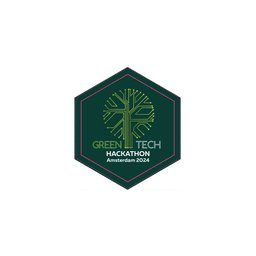

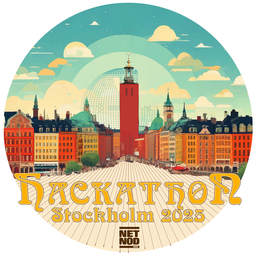
Comments 2
The comments section is closed for articles published more than a year ago. If you'd like to inform us of any issues, please contact us.
Mirjam Kühne •
Someone posted a comment here yesterday asking: "Do you have a list of worthwhile testers who might put my surplus credits to good use?" Unfortunately I accidentally deleted this comment so I am re-posting it.
Vesna Manojlovic •
This is a pair of frequent questions: 1) I have too many credits - who can I give them to? 2) I need more credits - who wants to give me some? Usually, people post their offers & requests to either "ripe-atlas@ripe.net" mailing list, or on Twitter, with a hashtag #RIPEAtlas or mentioning the user @RIPE_Atlas So please check and use either one of those. Thanks! Vesna